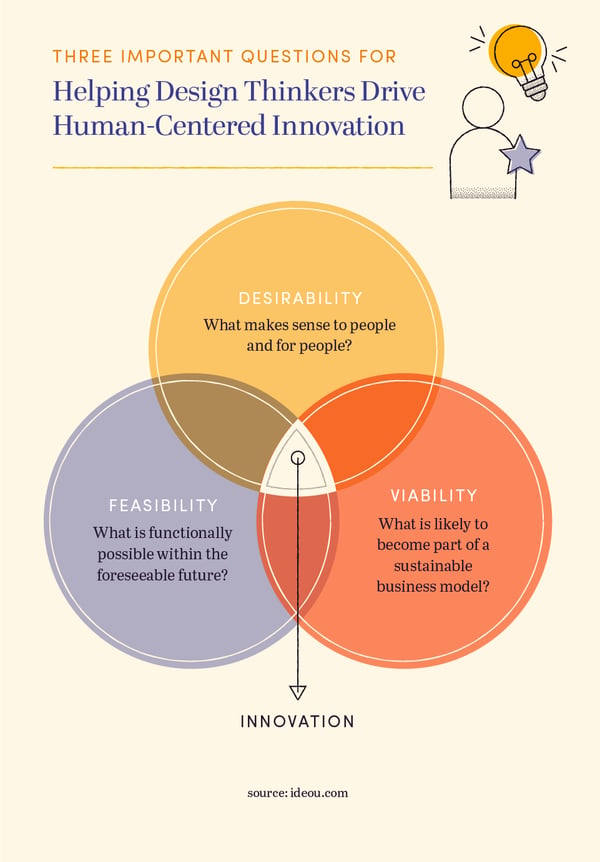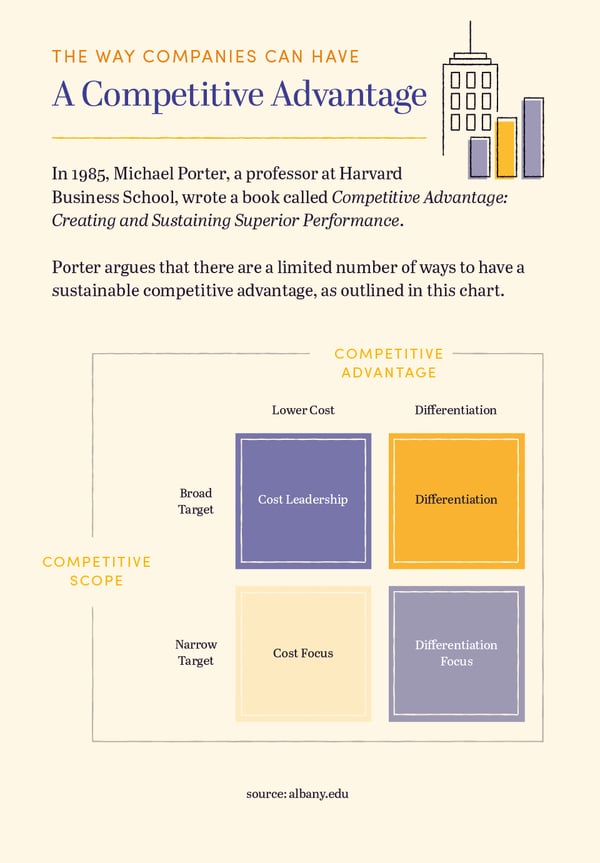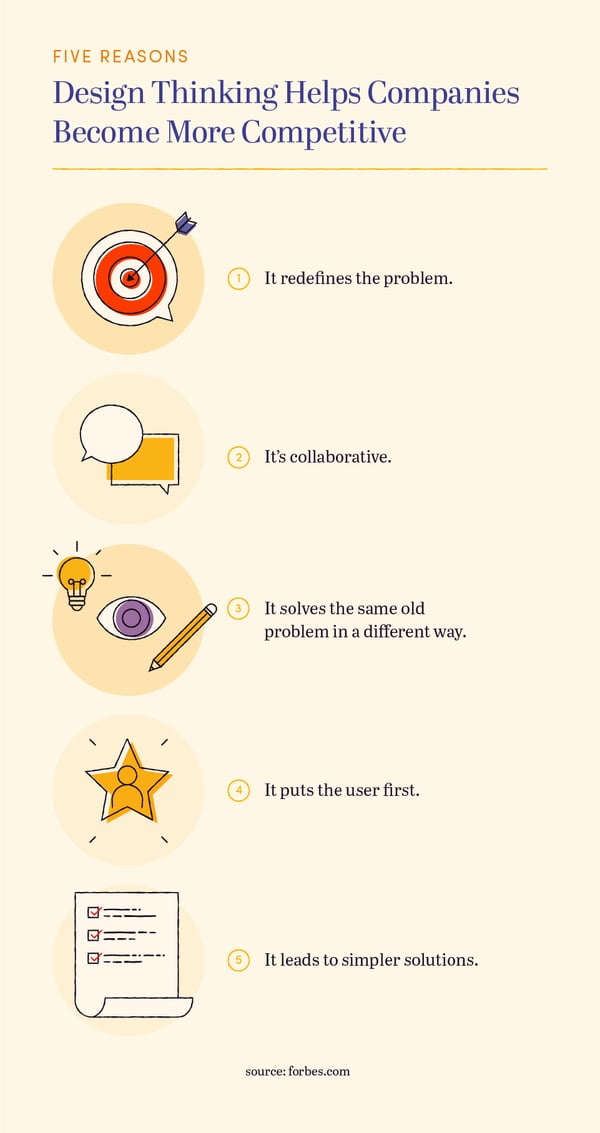How Design Thinking Creates a Competitive Advantage
Design thinking is about understanding the needs of someone (or something) who has a problem, especially a complex problem, then working on solutions that may solve the problem. This method of thinking can directly impact the customer experience and increase a company’s competitive advantage.
This article will define design thinking, explain what a competitive advantage is, and show how design thinking can directly affect competitive advantage.
What is design thinking?
Design thinking is the art of looking at a challenging or complex problem and, instead of seeing all the restraints or impossibilities, finding as many solutions as you can. Once you outline a number of solutions, you prototype the best ones and test them to find out which solution truly solves your customer’s problem.
The focus is entirely on the customer and their needs. It’s not about improving a certain key performance indicator (KPI) or metric.
Design thinking drives innovation. It has three main obstacles to overcome: a product or service’s desirability, feasibility, and viability. With each of those obstacles comes an important question that design thinkers must answer with their potential solutions.
-
Desirability: What makes sense to people and for people?
-
Feasibility: What is functionally possible within the foreseeable future?
-
Viability: What is likely to become part of a sustainable business model?

Companies use design thinking to be better. It gives them the opportunity to get to know their customers better, gather important data and research, and objectively create products and services their customers will appreciate.
However, design thinking isn’t just good for businesses. It also isn’t just for creating products or services. Non- and not-for-profit organizations, governments, and other groups can all use design thinking. If there is a complex problem, design thinking can help solve it.
For example, the City of Meridian, Idaho, reached out to ExperiencePoint to get help with growing pains. In this case, there was no product or service to sell to customers. They needed to figure out how to plan for the city’s long-range future in a strategic way. Using design thinking, they learned how to collaborate across departments. They also gained insight into how different departments functioned. With a better understanding of the government as a whole, and how each department affected others, the city was able to put together a strategic plan for handling growth and managing potential growing pains before they happened.
In the grand scheme of things, the City of Meridian did, in fact, create a competitive advantage for its businesses. With a healthy and effective government, businesses can run more smoothly, too, which, in turn, can help them grow more efficiently.
What, exactly, is a competitive advantage?
When a company — or any entity — pays attention to innovation that solves a complex issue, it likely sees a number of positive outcomes. One is that it can directly impact the customer experience and increase a company’s competitive advantage.
It’s important to understand what a competitive advantage is in order to really see how it can be changed. Surprisingly, many CEOs may not even know what their company’s competitive advantage is. In her book Creating Competitive Advantage, Jaynie Smith writes, “In my research with middle-market companies, I found only two CEOs out of 1,000 who could clearly name their companies' competitive advantages. The other 99.8 percent could offer only vague, imprecise generalities.”
According to Kimberly Amadeo, “A competitive advantage is what makes an entity's goods or services superior to all of a customer's other choices.” It relies on three points:
-
The benefit your product or service provides. Does it deliver true value?
-
Your target market. Do you truly understand your customers?
-
Your competition. How well do you know your competitive landscape?
The first two points correspond with the desirability tenet of design thinking. The last, concerning your competition, is more a function of viability: Can you make your product or service a part of your business model? Will it compete effectively?
A professor at Harvard Business School named Michael Porter wrote a book called Competitive Advantage: Creating and Sustaining Superior Performance. In it, he says, “Though a firm can have a myriad of strengths and weaknesses vis-a-vis its competitors, there are two basic types of competitive advantage a firm can possess: low cost or differentiation.”
There’s a third strategy for achieving competitive advantage, which is created when the competitive scope is narrowed. A company that uses the focus advantage, which is then combined with the low-cost or differentiation advantage, Porter says, “selects a segment or group of segments in the industry and tailors its strategy to serving them to the exclusion of others.”

Here are businesses in the vitamins and supplements industry that have different competitive advantages:
-
Cost leadership: Centrum, which produces vitamins for a wide variety of populations.
-
Differentiation: Deva Nutrition, which produces vitamins for a wide variety of populations, but set themselves apart by being vegan.
-
Cost focus: Evlution Nutrition, which produces low-cost vitamins and supplements for athletes.
-
Differentiation focus: Hammer Nutrition, which produces vitamins and supplements for athletes, but also aims to educate and serve those who are “health-conscious athletes.”
How does design thinking create a competitive advantage?
There are a number of ways to achieve each of the competitive advantages listed above. Most of them aren’t easy, and may not even involve creating a new product or service, but instead require a new process or business model.
This is where design thinking, with its two keys of feasibility (“Can we do this?”) and viability (“Can this be a sustainable part of our business model?”) comes into play. For example, you may already have a product that’s desirable, which is the third pillar of design thinking. However, if your target customers are asking for your current product at a lower price, without sacrificing quality, it’s time to turn to design thinking. With this method of problem solving, you’ll gain a new perspective on your company, your business, and what you can achieve.
Design thinking isn’t the easy way out, and for good reason. It’s a process that’s meant to solve the most complex problems your business or organization faces. Tim Brown, the CEO and president of IDEO, writes that design thinking is “not an inborn ability, it’s a skill — OK, a mastery — learned over many years of doing.”
If this process is time-consuming, why is it so important? According to Modicum, a digital creative agency, industry leaders are turning to design thinking for five reasons.
-
It redefines the problem.
-
It’s collaborative.
-
It solves the same old problem in a different way.
-
It puts the user first.
-
It leads to simpler solutions.

Furthermore, in using design thinking, companies often become more competitive in their industries. Netflix, for example, turned the movie rental industry upside down when it started, and has adapted over the years to become a household name. Other companies, Amazon being the largest, followed Netflix’s lead. It even disrupted the cable television and movie production industries. This all happened because it employed design thinking, adapted to what customers wanted, and followed the data and research to provide the latest and greatest innovations. Today, that means the first version of a “choose your own adventure”-style television experience with a special episode of “Black Mirror,” which, again, sets Netflix apart from its rivals.
Choose design thinking to create a sustainable competitive advantage.
Some companies and organizations can’t specify their competitive advantage. This is an important part of your business’s existence, and should be researched and well-understood by everyone in the company.
Once you know your competitive advantage, you can decide how to achieve it. With the variety of ways that exist to beat your competition, it may be difficult to decide how to become better: Should you create a new product or service? Improve what you already offer? Streamline the production process? The options are nearly endless.
Design thinking will help. When organizations turn to design thinking, they tackle complex problems in a way that encourages sustainable business practices. It removes the KPIs and stagnant ways of thinking at the very beginning of the process and fosters collaboration, innovative thinking, and solutions that truly help customers. With design thinking, everyone benefits.
Want to learn more about design thinking?